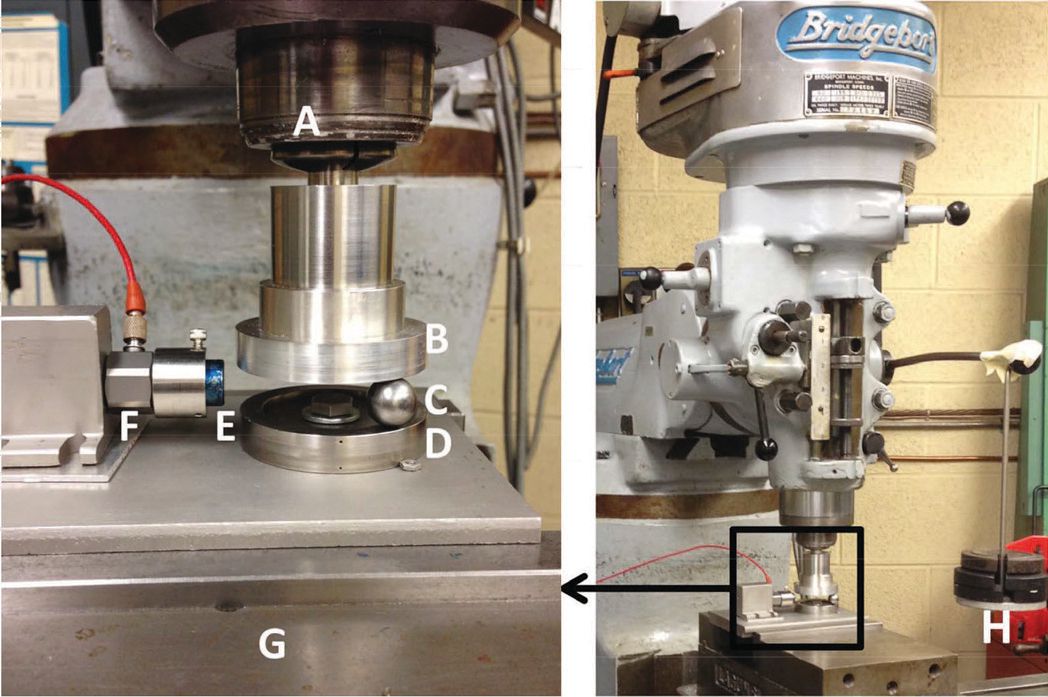MillSOT: A new approach to lubrication testing
Dr. Neil Canter, Contributing Editor | TLT Tech Beat August 2014
A new tribometer called a MillSOT places the spiral orbit tribometer on a standard milling machine.
KEY CONCEPTS
•
A spiral orbit tribometer simulates the workings of the simplest ball bearing.
•
Placement of a standard milling machine on the spiral orbit tribometer led to the development of a new tribometer known as a MillSOT.
•
The MillSOT provides good performance data and has the flexibility to offer additional testing capabilities at a low cost to the user.
THE SEVERE OPERATING CONDITIONS placed on lubricants and machinery have necessitated that thorough testing be conducted to ensure that performance parameters are met. Specific tests that need to be run are application dependent.
Thorough testing provides important data to predict how a lubricant will perform or how machinery will operate in a real-world application. This, at times, is not an exact science but gives as good a demonstration of lubricant effectiveness and machinery performance as can be obtained.
There are many different parameters that are looked at to judge lubricant and machinery performance. In a previous TLT article, a new parameter called fracture fatigue entropy was identified as a useful way to predict machinery failure (
1). Varying the experimental conditions in testing a specific material led to different operating results but still showed that failure occurred when the fracture fatigue entropy for the material is reached.
One of the leading instruments used to measure the performance of lubricants is the tribometer. Dr. Stephen Pepper, distinguished NASA research associate in Cleveland, says, “A tribometer is used to measure the coefficient of friction for a lubricant and also to determine the durability of a lubricant. No lubricant can last forever, as there is a limit on performance, and failure is inevitable.”
A unique tribometer known as the spiral orbit tribometer (SOT) was introduced in 2003 (
2). SOT simulates the workings of the simplest ball bearing, according to Pepper. He adds, “A ball is placed under a load and then driven in a near circular path, actually an opening spiral between two flat coaxial parallel plates. The ball is maintained between the two plates by a third flat guide plate. Sliding friction can be determined as a measure of the force of the ball on the guide plate by a transducer on the guide plate.”
While effective, the capability of the SOT can be expanded through a relatively simple modification that has just been developed.
MILLING MACHINE
The SOT has been placed on a standard milling machine to develop a new tribometer known as a MillSOT. Pepper says, “A milling machine is one of the least expensive ways to build and install a SOT. The hardware is simple enough to be fabricated on the same mill on which the tribometer is eventually installed.”
Figure 1 shows an image of the Mill- SOT with the key elements marked by letters. A is the mill’s spindle, B is the rotating plate, C is the ball, D is the stationary plate, E is the guide plate, F is the piezoelectric uniaxial compressive-mode force transducer, and G is the mill’s bed. A deadweight load on the ball is provided by hanging a weight, H, on the arm that lowers the spindle.
 Figure 1. The key elements in the MillSOT are shown by letter. The MillSOT has the potential to provide insightful data on specific lubricants and applications at a low expense. (Courtesy of NASA)
Figure 1. The key elements in the MillSOT are shown by letter. The MillSOT has the potential to provide insightful data on specific lubricants and applications at a low expense. (Courtesy of NASA)
Pepper indicates that the MillSOT is inexpensive to set up. He says, “The instrumentation is fairly inexpensive and includes a force transducer, charge amplifier (used to condition the signal from the transducer) and a data acquisition system hooked up to a computer laptop.”
Demonstration testing has been conducted to evaluate the capabilities of the MillSOT. Much of the testing focused on the evaluation of molybdenum disulfide. For example, an unlubricated ball was evaluated versus a ball lubricated with molybdenum disulfide powder in a dry, nitrogen purged environment. The conditions used were a deadweight load of 22.7 kg and a spindle rotational speed of 80 rpm.
A coefficient of friction value of approximately one was found with the unlubricated ball, while the molybdenum disulfide lubricated ball displayed a much lower coefficient of friction of 0.02. Pepper says, “Both of these values are reasonable based on past data generated by other test procedures.”
An interlab comparison was done to evaluate the accuracy and precision of the MillSOT. Pepper says, “Good agreement was seen among the testing labs.”
Pepper indicated that the MillSOT is very flexible so that other techniques can be used to obtain data on the performance of lubricants. One example is to run the tribometer at elevated temperatures. Pepper says, “Temperature can be regulated by placing a simple band heater around the plates. This could then provide further information on how a specific lubricant performs under different operating conditions.”
Pepper said that temperatures up to 200 C can be achieved with the band heaters.
Another valuable approach is to include a chemical analysis probe to evaluate changes in the composition of the lubricant in real-time. Pepper says, “The open geometry of the Mill- SOT makes it conducive to placing an infrared probe in close proximity to the ball. This means that real-time information could be obtained on the state of the lubricant over time at a specific temperature.”
The MillSOT is now available to anyone to set up and use. Pepper indicates that he is available to provide guidance. He says, “We can act as a test bed to assist new users with how to work with the MillSOT.”
Additional information on the Mill- SOT can be found in a recently published paper (
3) or by contacting Pepper at
stephen.v.pepper@nasa.gov.
REFERENCES
1.
Canter. N. (2011), “Predicting metal failure,” TLT,
67 (7), pp. 10-11.
2.
Pepper, S. and Kingsbury, E. (2003), “Spiral Orbit Tribometry – Part I: Description of the Tribometer,”
Tribology Transactions,
46 (1), pp. 57-64.
3.
Pepper, S. (2014), “The MillSOT – A Spiral Tribometer on a Milling Machine,” click
here.
 Neil Canter heads his own consulting company, Chemical Solutions, in Willow Grove, Pa. Ideas for Tech Beat items can be sent to him at neilcanter@comcast.net
Neil Canter heads his own consulting company, Chemical Solutions, in Willow Grove, Pa. Ideas for Tech Beat items can be sent to him at neilcanter@comcast.net.